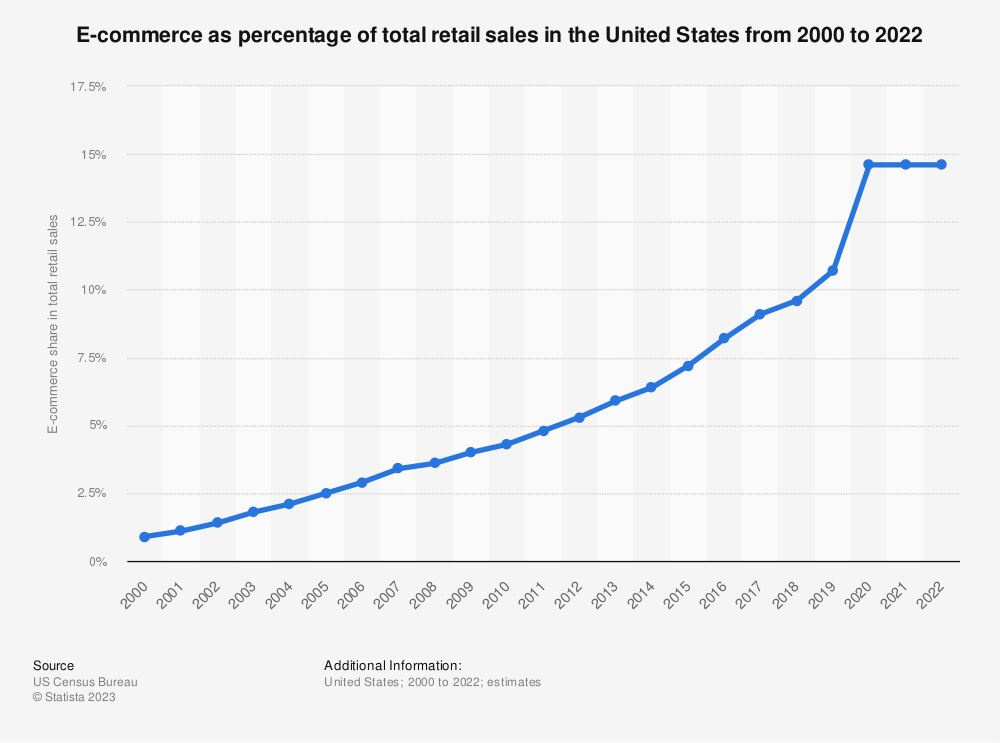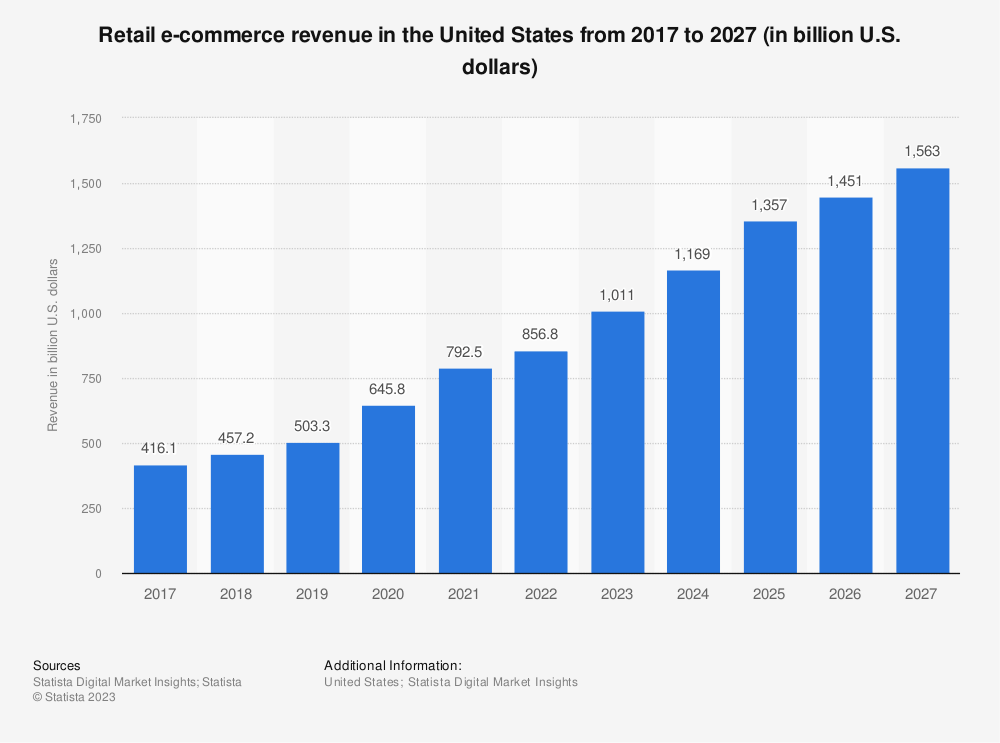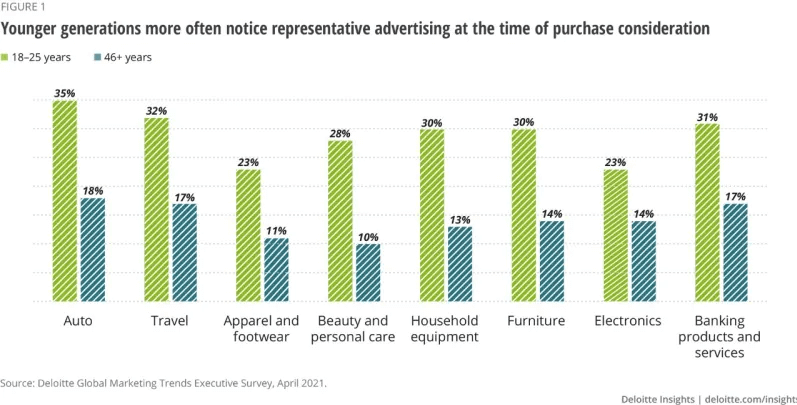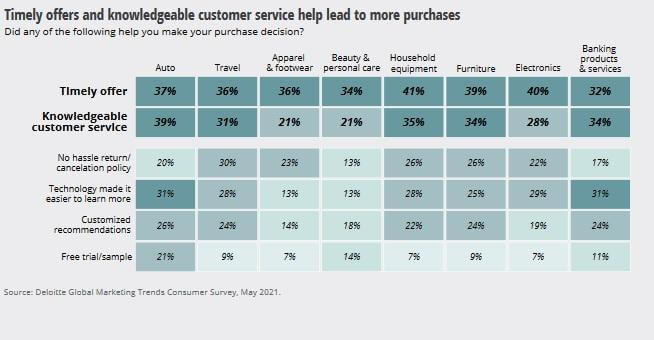Consumer behavior is the pillar and driver for numerous marketing strategies, as well as the object for marketing research, giving reliable information to ecommerce business owners. New marketing trends that we observe always stem from the changing consumer behavior patterns, keeping the sales world on its toes. Consequently, those who catch the drift and adapt to it the fastest way possible win the game. In the ideal, yet non-existing sales landscape that hardly changes, providing a unique and popular product or service would make your business forever profitable. Alas, it’s only day-dreaming, and nothing stays the same forever.
Contents:
1. Yesterday: From rags to abundance
2. Today: From consumerism to moderation
3. Tomorrow: From now to wherever analytical prediction takes
Yesterday: From rags to abundance
While back in 2000, the ecommerce sector made up 0.9% of total retail sales in the U.S. In 2022 this indicator amounted to 14.6%, which is basically a jump from nothing to the abundance we have today.

Let’s look closer at how tendencies and trends in consumer behavior and marketing were changing in the last 20 years. The first (almost) quarter of the 21st century is known for some quite distinct changes in the sales world, according to the Deloitte report “Re-invent sales for the 21st century”:
- New sales technologies in the form of mobile apps and platforms totally transformed the sales landscape, and now, 20 years after, seem like something a customer would easily take for granted.
- Customers, in their turn, became more sophisticated and savvier having access to more information, enjoying growing competition among sellers and expecting better value at a lower price combined with convenience.
Multi-channel sales is one more feature of the sales landscape in the 21st century: a unique combination of online stores, brick and mortar stores, ecommerce sites complementing each other, giving way in some situations and gaining in others.
- It’s hard to deny the social media power that governs many processes today, including sales. It might be a great tool to reach larger audiences, but it needs defined ICPs, constant attention, content creation and monitoring.
- Ecommerce sector is growing exponentially with the revenue of about $1 trillion in 2023 in the U.S., which is twice as much as five years ago.

In short, it’s safe to say that the first two decades of the 21st century saw a savvy and sophisticated customer, enjoying various shopping opportunities and a huge variety of goods and services to choose from provided by ecommerce businesses.
Today: From consumerism to moderation
If we turn to the global situation today with the increasing cost of living worldwide and the resulting inflation, we might see a drastic change from consumerism to more frugal spending habits among consumers. Moderation and avoidance are the dominating trends today. All these changes manifest themselves in consumers focusing less on product quality and more on value for money. Businesses, in their turn, are trying to provide better value-for-money options, discounts, and multi-functional products in an attempt to address the growing concerns about personal financial situation of consumers. This is a general overview of the “Spending Priorities – Consumer Behavior Trend Analysis” by marketresearch.com.
If we turn to the Deloitte report “2022 Global Marketing Trends” based on two global surveys and 18 in-depth interviews with global executives, which proves its global relevance, we’d see a set of marketing trends reflecting consumer preferences. This report named 2022 a year of recovering and for some businesses even thriving in the customer-centric world, as opposed to 2021, which was focused on responding to an unprecedented shock of the pandemic 2020.
The data gathered during the polls and interviews helped to outline the following global marketing trends and strategies, and if we go a step further, these trends can give us a clear idea about consumer behavior and preferences.
1. Purpose-a beacon for growth
The Deloitte survey of customers states that one third of consumers under 25 years old opt for sustainability as a top criterion when buying beauty and personal care products. A quarter of customers choose data privacy for their banking decisions, and more than a half (57%) of customers agreed that their loyalty to brands is fostered by the brands’ commitment to address social inequalities. According to the 2022 Edelman Trust Barometer findings, about a half of the respondents believe that businesses should do more to address societal problems (climate change – 52%, economic inequality – 49%, workforce reskilling – 46%, trustworthy information – 42%). That leads to a conclusion that while the price-quality ratio is still important, there’s a growing preference of the” higher purpose” among customers.
As a response to these consumer preferences, many companies today are trying to redefine their purpose beyond profit and focus on some “higher purpose” like solving ecological problems or fighting inequality to resonate with their customers.
2. Authentically inclusive marketing
While consumers of today are getting more and more diverse in terms of their ability, race and ethnicity, beliefs, their needs and preferences differ significantly.
Consequently, businesses are trying to reflect these differences by supporting diversity and inclusion in public and behind the camera, which helps win future customers, especially younger generations.
The results of the Global Marketing Trends Executive Survey showed that high-growth brands (those with the annual revenue growth of 10% or more) are more frequently using DEI (key performance metrics for diversity, equity, and inclusion) in comparison to their lower-growth competitors. So DEI is becoming a strategic priority for 94% of CEOs.

3. Meeting customers in a cookieless world
Advances in AI and big data allowed businesses to target their customers better using third-party cookies, but at the same time ignited some security concerns among customers. So today’s trend is reversing to data privacy to respect the needs of clients. This trend resulted in a number of restrictions, regulations and disabling third-party cookies, which had its adverse effect on the previously effective customer engagement techniques.
61% of high-growth companies are shifting to a first-party data strategy, while only 40% of negative-growth companies follow this strategy. All in all, rethinking analytics, cultivating unique first-party data through offering value in exchange help to build more trustworthy relationships with customers.
4. Designing a human-first data experience
As long as we’re talking about sophisticated and picky customers, enjoying competition, making customer experience better has always been the purpose of marketing, which relies on detailed customer data. With a considerable setback in data tracking resulting from customer privacy concerns, marketers are trying to gain customers’ trust back. It’s obvious that geo-tracking, active device listening, and third-party cookie-based recommendations can scare off customers, to say the least.
The survey of customers mentioned before looked at 10 brand interactions that use customer data and asked respondents to rate the interaction on a scale of creepy to helpful. While 68% of customers found their favorite brand sales alerts really helpful, 53% deemed active device listening creepy.
Today brands gravitate towards involving privacy and security teams from day one, earning customers’ trust before implementing deeper tracking methods and giving customers choice in terms of providing businesses with their personal information.
5. Elevating the hybrid experience
Looking for convenience in everyday life, many customers shift a huge part of their lives to the digital world. Remote working, telemedicine, studying online, ecommerce are just a few examples of this shift. In an attempt to cater to their customers, successful brands are working on the implementation of new hybrid customer experiences. In a nutshell, more and more brands focus on a working blend of physical and digital experiences. The Global Marketing Trends Executive Survey results showed that 75% of global executives were planning to invest more in delivering hybrid experiences, including personalization (43%), innovation (43%), customer connection (40%), and inclusion (38%). Businesses are ready to meet their customers in their preferred channels and make their decisions relying on rapid feedback from the clients.
6. Supercharging customer service with AI
It’s hard to underestimate the meaning of customer service in the world of ecommerce today. According to the customer survey, when the customers were asked about the most helpful options while making purchase decisions, the most common answers were “timely offer” and “knowledgeable customer service”. These two marketing tactics are successfully delivered by AI: getting the right offers to customers at the right time and providing customers with great post-sales service.

As we see, AI potential is only unfolding today and will surely find many applications. However, when it comes to customer service, AI and contact centers with human customer agents shouldn’t be mutually exclusive, but rather work harmoniously to deliver the best service.
Having in mind that 37.9 % of retail ecommerce market share belongs to Amazon, it seems logical to elaborate on the results of another report on customer behavior by Jungle Scout. “Generational trends in consumer behavior” focuses on generational differences among Gen Z, Millennial, Gen X, and Baby Boomer customers in terms of spending habits and ecommerce shopping and is based on a study of 1000 shoppers around the U.S. The insights of the report are quite revealing.
When it comes to the place where people buy, Walmart (61%), Target(29%), Walgreens (20%) are the top 3 for in store shopping, while Amazon(68%), Walmart.com (40%) and eBay.com (17%) are chosen more often for online shopping.
When looking at money-saving strategies, one can see some significant difference among generations. Baby Boomers (73%) and Gen Z (60%) are more likely to buy items on sale than Millennials (42%) and Gen Z (41%). At the same time, Millennials (35%) and Gen Z (32%) are more brand-conscious and less likely to buy from cheaper brands in comparison to Gen X (49%) and Baby Boomers (54%). When it comes to buying used products, Gen Z and Gen X are taking the lead with 21% and 20% respectively, while only 11% of Baby Boomers and 17% of Millennials tend to buy used products.
In terms of online shopping frequency, Gen Z consumers are leading with 32% shopping online once a day or more, compared to just 7% of Baby Boomers.
If we look at how customers from different generations start their online product search, Baby Boomers and Gen X prefer Amazon, search engines and Walmart.com, while Gen Z and Millennials add YouTube (42% and 34% for Gen Z and Millennials respectively, TikTok (43% and 23%) and Instagram (36% and 26%) to that list.
These insights might be of help when trying to adjust business processes to the shifting preferences of the customers and see the future trends gaining traction.
Tomorrow: From now to wherever analytical prediction takes
Making predictions about any spheres of life is quite a risky business, yet the wish to have a sneak peek at what is in store for us is so strong that one can hardly resist it. The ability to correctly predict some marketing tendencies based on the changing consumer behavior might give a real head start on the competition. We’ll try to make a few predictions of how ecommerce business is going to change in the next 5–10 years based on the tendencies that are dominating the market now.
1. A blend of AI and human service
Observing revolutionary changes that the advances of AI are bringing about in many spheres, including ecommerce, and a certain degree of rejection of these changes by some people at least now, it’s safe to say that the future of marketing and ecommerce seems to be a seamless and effective blend of AI and human service. If we take a step further, judging from how fast many people are adopting AI technologies to help them do various things, there’s a solid chance that the future of shopping might be the interaction of two AIs, one on the side of the seller and the other on the side of the buyer, which should be quite smooth and designed to benefit both the customer and the seller.
2. Brick and mortar vs online
Brick and mortar shop model is becoming the most sustainable model, with a lot of large brands having online sales at 25-30% rate and growing. Though some brands might be struggling now, closing shops in some locations and opening in others, it doesn’t feel right to say that brick and mortar shops will be totally replaced by online stores. Let’s not forget that ecommerce is 14.6% of total US retail as of 2022, according to the Census Bureau of the Department of Commerce. While total ecommerce sales for 2022 had an increase of 7.7 % from 2021, total retail sales in 2022 increased by 8.1 % from 2021.
No matter how well some products may be described, photographed and videoed in online shops, nothing compares to touching, seeing, smelling, especially when it comes to choosing some product categories. Having in mind that tangible and sensory experience is hard to beat, we believe that the future will favor a working combination of online stores and brick and mortar shops, which will most likely function as a “gallery”, giving aesthetic pleasure to their visitors and a chance to assess products first hand combined with some recommendations from consultants.
3. Real personalized experience for every buyer
With the help of AI technologies it may become possible to categorize customers not by cohorts (occupation, location, gender, age etc.), but make more subtle categories inside these cohorts so that it’ll really look and be personal. That will help make almost 100% accurate predictions about customer preferences just about anything ranging from color and music to the preferred style of communication and advertisements that one likes. Having a real personalized experience while shopping is what customers dream about as it makes the process easier, faster and more pleasant. For ecommerce in its turn, it provides countless opportunities to grow and prosper.
Wrapping up
Consumer behavior has been the driving force behind evolving marketing strategies in the ecommerce landscape. From the early days of ecommerce, where it represented a small portion of retail sales, to the present, where it has grown exponentially, consumer behavior has shaped the way businesses operate. We’ve witnessed significant changes, such as the adoption of mobile technologies, increased consumer sophistication, and the rise of multi-channel sales.
Today, as we navigate economic challenges and shifting priorities, we see a shift from consumerism to moderation. Consumers are emphasizing value for money, and businesses are responding with value-driven options and discounts. Purpose-driven marketing and inclusivity are also emerging as key trends, reflecting changing consumer preferences.
Looking ahead, we predict a future where AI and human service seamlessly blend to enhance the shopping experience. Brick-and-mortar stores will continue to coexist with online shopping, providing a sensory experience that complements digital convenience. Personalization will reach new heights, with AI categorizing customers on a more subtle level to deliver highly tailored experiences.
While predicting the future is risky, these trends suggest that ecommerce will remain a dynamic and ever-evolving industry, with consumer behavior continuing to be at its core. Adapting to these changes will be essential for businesses seeking to thrive in the years to come.

%20(1).png)





